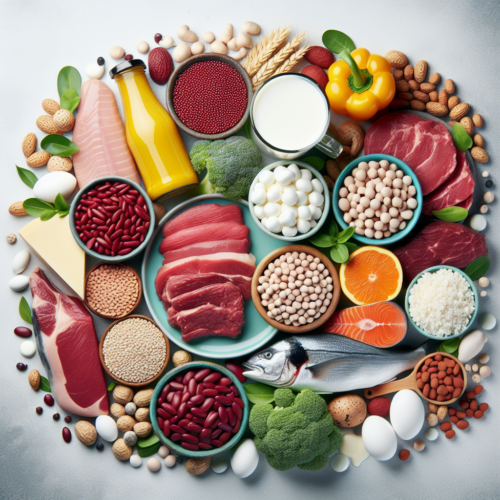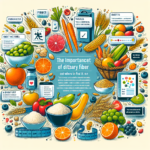When it comes to dining out, making healthier food choices can be a challenge. However, with a few simple strategies, you can navigate restaurant menus and make choices that support your overall health goals. It’s important to be mindful of portion sizes, opting for smaller portions or sharing a dish with a friend. Look for menu options that are grilled, steamed, or baked, as these cooking methods tend to be healthier than fried or breaded options. Additionally, choosing dishes that are rich in vegetables and lean proteins can help you stay on track with your nutritional goals. By being aware of what you’re ordering and making conscious choices, you can easily make healthier food choices when eating out.
In This Article
ToggleHow to choose healthier options at restaurants
Eating out at restaurants can be a fun and enjoyable experience, but it’s important to make healthier food choices to support your overall health. By being mindful of your options and making simple modifications, you can still enjoy delicious meals while staying on track with your health goals. Here are some tips to help you choose healthier options when dining out:
Research the menu beforehand
Before heading out to a restaurant, take some time to research the menu online. Many restaurants now provide their menus on their website or through apps, which allows you to review the options beforehand. This will give you the opportunity to choose dishes that align with your dietary preferences and health goals.
Look for keywords on the menu
When looking at a menu, keep an eye out for keywords that indicate healthier options. Words like “grilled,” “baked,” “steamed,” and “broiled” are often associated with healthier cooking methods. Dishes that are described as “fresh,” “light,” or “vegetable-based” are also good indicators of healthier choices.
Opt for grilled or baked options
Choosing grilled or baked options instead of fried ones can significantly reduce the amount of unhealthy fats and calories in your meal. Grilled or baked proteins such as chicken, fish, or tofu are excellent choices that provide ample nutrition without the added grease. These cooking methods allow the natural flavors of the food to shine through without the need for excessive oil or breading.
Choose dishes with plenty of vegetables
Vegetables are a great source of essential vitamins, minerals, and fiber. When choosing a dish, look for options that include plenty of vegetables. Salads, stir-fries, and vegetable medleys are usually excellent choices. Not only do they add nutritional value to your meal, but they also provide a satisfying crunch and vibrant flavors.
Request modifications to your meal
Don’t hesitate to request modifications to your meal to make it healthier. Whether it’s asking for sauces or dressings on the side, substituting high-calorie ingredients, or opting for whole grain alternatives, most restaurants are usually willing to accommodate your requests. Remember, it’s about taking control of your choices and making adjustments to suit your individual needs.
Avoid high-calorie extras
Many restaurants offer high-calorie extras such as bread baskets, butter, or creamy sauces. While they may be tempting, it’s best to avoid or limit these extras. Instead, focus on the main components of your meal and choose healthier options that will keep you satisfied without piling on unnecessary calories.
Watch out for hidden sugars in beverages
Beverages can be a hidden source of added sugars, which can contribute to weight gain and other health issues. Be cautious of sugary drinks such as sodas, sweetened teas, or fruit juices. Opt for water, unsweetened tea, or other low-calorie alternatives instead. If you prefer a little flavor, try adding a slice of lemon or cucumber to your water for a refreshing twist.
Ask for sauces and dressings on the side
Many restaurant dishes are accompanied by heavy sauces and dressings that can be high in calories and unhealthy fats. To control the amount you consume, ask for these condiments to be served on the side. This way, you can add as much or as little as you like, allowing you to enjoy the flavors without going overboard on the calorie count.
Control portion sizes
Portion sizes at restaurants are often larger than what we actually need. It’s important to be mindful of how much you eat. To prevent overeating, consider sharing a dish with a friend or family member, or ask for a to-go box at the beginning of the meal and portion out the excess food to save for another time. Another option is to order appetizers or smaller-sized portions to automatically reduce portion sizes.
Practice mindful eating
One of the most important tips for choosing healthier options at restaurants is to practice mindful eating. Slow down, savor each bite, and pay attention to your body’s hunger and fullness cues. By being present and enjoying your meal, you’ll be less likely to overeat and more in tune with your body’s needs.

Dealing with specific types of restaurants
While the tips mentioned above can be applied to most restaurants, it’s helpful to have some specific strategies for different types of cuisines. Here are some additional tips for making healthier choices at various restaurant types:
Fast food restaurants
Fast food restaurants often have a reputation for being high in calories, unhealthy fats, and sodium. However, you can still make healthier choices by following these tips:
- Choose grilled chicken instead of fried options.
- Opt for a side salad or fruit instead of fries.
- Skip the soda and choose water or unsweetened tea.
- Avoid mayonnaise-based sauces and spreads.
- Request no or light cheese on your burgers or sandwiches.
- Limit your condiments to reduce added sugars and fats.
- Control your portion sizes by opting for smaller burgers or choosing from the kids’ menu.
- Avoid combo meals, as they often come with larger servings and extra calories.
- Choose healthier breakfast options such as oatmeal or egg-based dishes.
- Look for lower calorie options on the menu, such as salads or wraps with lean proteins and plenty of vegetables.
Italian restaurants
Italian cuisine is known for its rich flavors and hearty dishes. Here’s how you can make healthier choices at Italian restaurants:
- Choose tomato-based sauces like marinara or arrabbiata over cream-based options such as alfredo.
- Opt for whole grain or vegetable-based pastas.
- Include plenty of vegetables in your dish, such as grilled peppers, zucchini, or spinach.
- Share a larger portion with a friend or take half home for later.
- Choose grilled or baked protein options like chicken or fish instead of breaded and fried ones.
- Avoid excess cheese and bread by asking for lighter amounts or skipping them altogether.
- Limit your intake of breadsticks and appetizers, as they can add unnecessary calories.
- Stay away from high-calorie desserts and opt for a side of fresh fruit or a simple sorbet.
- Order a side of steamed vegetables or a salad to add more fiber and nutrients to your meal.
Asian restaurants
Asian cuisine offers a variety of tasty options, but it’s important to make wise choices. Consider these tips when dining at Asian restaurants:
- Choose steamed or stir-fried dishes instead of deep-fried ones.
- Opt for brown rice instead of white rice for more fiber and nutrients.
- Include plenty of vegetables in your meal, such as broccoli, bok choy, or snow peas.
- Choose broth-based soups over creamy or coconut-based ones.
- Limit your intake of fried or breaded dishes, such as tempura or spring rolls.
- Avoid excessive amounts of sauces and condiments, as they can be high in sodium and sugar.
- Watch out for high-sodium dishes like soy sauce or certain noodle dishes.
- Choose lean protein sources like tofu, fish, or chicken instead of fatty meats.
- Avoid fried appetizers and opt for a side of steamed vegetables to increase your nutrient intake.
Mexican restaurants
Mexican cuisine can be flavorful and healthy if you make the right choices. Here’s how to navigate Mexican restaurants for healthier options:
- Choose grilled or roasted meat options like chicken or lean cuts of beef.
- Opt for whole wheat or corn tortillas instead of flour tortillas.
- Include plenty of veggies in your meal by choosing fajitas or vegetable-filled enchiladas.
- Avoid dishes with excessive cheese and sour cream, or ask for them on the side.
- Limit your intake of deep-fried foods like chimichangas or churros.
- Choose salsa or guacamole as a healthier topping for your tacos or burritos.
- Avoid high-calorie margaritas and sugary drinks, and opt for water or light beer instead.
- Control portion sizes by sharing a meal or saving half for later.
- Order a side of black beans or pinto beans instead of refried beans, which can be high in fat.
- Choose dishes with lean protein sources like chicken or fish instead of fatty meats.
Steakhouses
Steakhouses are known for their indulgent and meaty dishes, but there are still ways to make healthier choices. Consider these tips when dining at a steakhouse:
- Choose lean cuts of meat like sirloin or filet mignon instead of fattier options.
- Opt for smaller portion sizes or share a larger steak with someone else.
- Include plenty of vegetables in your meal, such as grilled asparagus or a side salad.
- Avoid high-fat side dishes like loaded potatoes or creamed spinach.
- Skip the creamy sauces and gravies, or ask for them on the side.
- Choose grilled or broiled options instead of breaded or fried meats.
- Control your intake of high-calorie appetizers and desserts by sharing or choosing smaller portions.
- Order a side salad or steamed vegetables instead of fries to add more nutrients to your meal.
- Avoid excessive butter and oil by requesting your steak to be prepared with less or none.
Seafood restaurants
Seafood restaurants can offer a variety of nutritious options, but it’s important to make wise choices. Here’s how to choose healthier options at seafood restaurants:
- Choose grilled or broiled fish instead of fried options.
- Opt for seafood options with fewer added sauces or ask for them on the side.
- Include plenty of vegetables in your meal, such as steamed broccoli or a mixed vegetable stir-fry.
- Avoid deep-fried seafood dishes like fish and chips or fried calamari.
- Choose whole grain or brown rice as a side instead of white rice.
- Control portion sizes by ordering just enough to satisfy your hunger.
- Avoid creamy or buttery sauces that can add unnecessary calories.
- Watch out for excessive salt in your dishes, as some seafood can be naturally high in sodium.
- Limit your intake of fried appetizers and seafood platters, and instead opt for healthier starters.
- Choose steamed or boiled seafood when possible to retain nutrients without adding extra fats.

Vegetarian and vegan restaurants
Vegetarian and vegan restaurants offer a wide range of plant-based options that can be both nutritious and delicious. Here’s how to make healthier choices when dining at these establishments:
- Opt for whole food plant-based options that are minimally processed and rich in nutrients.
- Include a variety of vegetables, legumes, and grains in your meal to ensure a balanced plate.
- Choose dishes with plenty of fiber and protein, such as lentil soups or quinoa salads.
- Avoid highly processed vegetarian options like mock meats or heavily processed soy products.
- Limit your intake of fried foods and heavy sauces, as they can be high in unhealthy fats and calories.
- Choose steamed, grilled, or roasted options for healthier cooking methods.
- Control portion sizes by being mindful of how much you eat.
- Watch out for added sugars in vegetarian dishes, especially in dressings or sauces.
- Choose fresh fruit or sorbet for dessert instead of options high in added sugars.
- Ask for dressings or sauces made without added oils to minimize unhealthy fats.
Buffets
Buffets can be a challenging place to make healthier choices due to the wide variety of tempting options. However, with these tips, you can still enjoy a balanced meal at a buffet:
- Start by surveying all the options before filling your plate. This way, you can make informed choices and prioritize healthier options.
- Fill half of your plate with a variety of colorful vegetables. Choose raw or steamed options whenever possible.
- Opt for lean proteins like grilled chicken or fish instead of fried or heavily marinated ones.
- Choose whole grains like brown rice or quinoa over refined grains like white rice or pasta.
- Control your portion sizes by taking small amounts of each dish and avoiding multiple trips to the buffet line.
- Be mindful of your hunger and fullness cues, and eat until you’re satisfied, not overly full.
- Choose water or unsweetened beverages instead of sugary sodas or fruit juices.
- Limit your intake of high-calorie items like fried foods, creamy sauces, and desserts.
- Use smaller plates or bowls to help control portion sizes and avoid overeating.
Food trucks
Food trucks have become increasingly popular in recent years, offering a wide range of cuisines in a casual setting. Here’s how you can make healthier choices when eating at food trucks:
- Look for food trucks that offer healthier options or specialize in specific cuisines that align with your dietary preferences.
- Choose grilled or baked options over fried ones whenever available.
- Opt for whole grain or lettuce wraps instead of traditional buns or tortillas.
- Include plenty of vegetables in your meal by choosing veggie-filled options or adding extra veggies to your dish.
- Avoid heavy sauces or ask for them on the side to control the amount you consume.
- Control your portion sizes by ordering smaller portions or sharing with a friend.
- Choose protein sources like lean meats, tofu, or legumes over higher fat options.
- Avoid excessive amounts of cheese, mayo, or other high-calorie toppings.
- Look for food trucks that offer healthier cooking methods, such as grilling or steaming.
- Keep in mind that many food trucks offer a variety of options, so take the time to explore all your choices before making a decision.
Coffee shops
Coffee shops are not just for coffee anymore – they also offer a wide array of food and drink options. To make healthier choices at coffee shops, consider the following tips:
- Choose black coffee or unsweetened tea instead of sugary beverages like flavored lattes or frappes.
- Opt for low-fat or plant-based milk options like skim milk, almond milk, or soy milk.
- Limit your intake of flavored syrups and whipped cream, which can add unnecessary calories.
- Choose whole grain or protein-rich breakfast options like oatmeal or avocado toast.
- Avoid high-calorie pastries and baked goods, such as muffins or croissants.
- Control your portion sizes by choosing smaller sizes or sharing treats with a friend.
- Ask for half the sweetener or a smaller size in coffee drinks to cut down on added sugars.
- Avoid adding excessive sugar to your beverages by starting with less and adjusting to taste.
- Choose fresh fruit or a small yogurt as a snack option instead of high-calorie baked goods.
- Stay hydrated with water throughout the day, as coffee can have a diuretic effect and lead to dehydration if consumed in excess.
In conclusion, making healthier choices at restaurants is not as challenging as it may seem. By doing a little research, being mindful of your options, and making simple modifications, you can enjoy a delicious meal while still supporting your overall health. Remember to listen to your body’s needs, practice portion control, and choose nutrient-dense options whenever possible. With these tips in mind, you can dine out with confidence and continue to nourish your body in a way that aligns with your health goals.
FAQ
1. Why is it challenging to make healthier food choices when eating out? Dining out can make it harder to control what’s in your food, and restaurant menus often feature larger portions and less healthy cooking methods.
2. How can I prepare for healthier eating at restaurants? Research the menu beforehand, using websites or apps, to find dishes that align with your dietary preferences and health goals.
3. What keywords on the menu indicate healthier options? Look for words like “grilled,” “baked,” “steamed,” “broiled,” “fresh,” “light,” and “vegetable-based,” which suggest healthier cooking methods and ingredients.
4. Why should I opt for grilled or baked options? Grilled or baked dishes usually have less unhealthy fats and calories compared to fried options, and they allow the natural flavors of the food to come through without excess oil or breading.
5. What types of dishes should I choose for better nutrition? Select dishes rich in vegetables, as they provide essential vitamins, minerals, and fiber. Salads, stir-fries, and vegetable medleys are usually good choices.
6. Can I request modifications to my meal at a restaurant? Yes, don’t hesitate to ask for modifications like sauces on the side, substituting high-calorie ingredients, or opting for whole grain alternatives.
7. How can I avoid unnecessary calories at restaurants? Avoid high-calorie extras like bread baskets, butter, or creamy sauces, and focus on the main components of your meal.
8. Why should I be cautious of sugary beverages? Beverages can be a significant source of added sugars, contributing to weight gain and other health issues. Opt for water, unsweetened tea, or low-calorie alternatives instead.
9. How can I manage the calorie content of my meal effectively? Ask for heavy sauces and dressings to be served on the side, so you can control the amount you consume.
10. What strategies can help control portion sizes at restaurants? Consider sharing a dish, asking for a to-go box at the start of the meal, or ordering appetizers or smaller-sized portions to reduce the size of your meal.
11. What is mindful eating and how can it help at restaurants? Mindful eating involves slowing down, savoring each bite, and paying attention to your body’s hunger and fullness cues. This approach can help prevent overeating.
Related posts:
 What are the benefits of eating organic foods?
What are the benefits of eating organic foods?
 The Importance of Dietary Fiber and Where to Find It
The Importance of Dietary Fiber and Where to Find It
 How can I ensure I’m getting enough vitamins and minerals?
How can I ensure I’m getting enough vitamins and minerals?
 What are simple ways to reduce sugar in my diet?
What are simple ways to reduce sugar in my diet?
 What are healthy fats and how can they benefit my diet?
What are healthy fats and how can they benefit my diet?
 What are the best sources of protein for a healthy diet?
What are the best sources of protein for a healthy diet?








No comment yet, add your voice below!